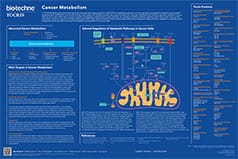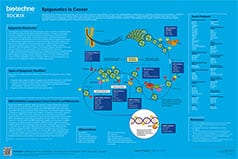Tumor Microenvironment
The tumor microenvironment (TME) is the area of interaction between cancer cells and non-transformed cells. This area can contain cells of the immune system, tumor vasculature, fibroblasts and pericytes, providing multiple targets for therapeutic intervention.
Tumor Microenvironment Product Areas
The tumor microenvironment (TME) refers to the area of interaction between malignant and non-transformed cells, and can contain cells of the immune system, tumor vasculature and lymphatics, fibroblasts, pericytes and sometimes adipocytes. The TME is regulated by intercellular communication via a diverse network of cytokines, chemokines, growth factors, inflammatory enzymes and matrix remodeling enzymes. Although the exact composition of the TME varies across different forms of cancer, many features are common and as such, targeting of either the cells of the TME or the mediators of cellular communication, could have therapeutic applications across a range of cancer types.
Cancer-associated fibroblasts
Cancer-associated fibroblasts (CAFs) play various roles in the TME; remodeling the extracellular matrix (ECM), inducing angiogenesis, recruiting inflammatory cells and directly stimulating cancer cell proliferation through secretion of growth factors and immunosuppressive cytokines. For example, chemokine (CXC) ligand 12 (CXCL12) from CAFs promotes the growth and survival of malignant cells.
Extracellular Matrix
The ECM is not only a physical scaffold but also plays a role in the evolution and spread of cancers. It contains key growth factors, angiogenic factors and cytokines that interact with cell surface receptors on cells of the TME. CAFs and tumor-associated macrophages (TAMs) secrete matrix metalloproteases (MMPs) that degrade ECM proteins, releasing chemokines, as well as angiogenic and growth factors.
Immune cells
Multiple cells of the immune system can be found in the TME. Although tumor associated antigens may stimulate an immune response to clear the tumor, cancers can also evade immune responses by recruiting immunosuppressive cells. For example, regulatory T-cells exert an immunosuppressive function, inhibiting the recognition and clearance of tumor cells. Similarly, TAMs are pro-tumorigenic, as well as being a major contributor to tumor angiogenesis.
Tumor vasculature
Many factors within the TME stimulate endothelial cells and neovascularization within cancer, including vascular endothelial growth factors (VEGFs), fibroblast growth factor and chemokines. VEGF-A is the predominant angiogenic factor in the TME and is produced by malignant cells and lymphocytes.
Literature for Tumor Microenvironment
Tocris offers the following scientific literature for Tumor Microenvironment to showcase our products. We invite you to request* or download your copy today!
*Please note that Tocris will only send literature to established scientific business / institute addresses.
Cancer Metabolism Poster
This poster summarizes the main metabolic pathways in cancer cells and highlights potential targets for cancer therapeutics. Genetic changes and epigenetic modifications in cancer cells alter the regulation of cellular metabolic pathways providing potential cancer therapeutic targets.
Epigenetics in Cancer Poster
This poster summarizes the main epigenetic targets in cancer. The dysregulation of epigenetic modifications has been shown to result in oncogenesis and cancer progression. Unlike genetic mutations, epigenetic alterations are considered to be reversible and thus make promising therapeutic targets.


